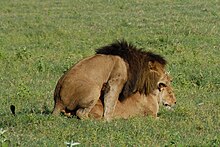Mating bite

In the mating bite, the male bites into the flank or the neck ( neck bite ) of the female in order to prevent the partner from running away during the intended mating .
The bite itself is part of the mating behavior. The teeth often do not penetrate, but usually exert a stimulating stimulus, since the male usually does not use the full force of the jaw muscles. Nevertheless, injuries can occur, but in most cases these are mild and are usually limited to minor tissue injuries . However, injuries can also be fatal, especially in the case of predators or in the absence of opportunities to escape.
Animal groups
There is a mating bite in some reptile and mammal species .
Reptiles
In reptiles, the male often takes the mating bite as a flank bite. Then the rear part of the female is raised by the head of the male, only then can the mating take place.
snakes
The mating bite as a flank bite occurs in the mating behavior of many snakes , e.g. B. in Italian Aesculapian snakes .
Scaly creepers
Many scalloped reptiles such as lizards or agamas use the flank bite in their mating behavior.
Mammals
In mammals, the shape of the neck bite dominates as a mating bite. It is sometimes practiced by the physically stronger male regardless of the female's willingness to mate. This is especially true of predators:
Feline
The neck bite occurs frequently in the mating behavior of feline species , including jaguarundi ( Puma yagouaroundi ) and lions .
Canine
Among the canine species , for example, the little panda ( Ailurus fulgens ) shows a similar behavior.
seals
The neck bite is also part of the mating behavior of seals such as Steller's sea lions and northern or southern elephant seals .
Horses
In horses (Equidae) and zebras, the stallion fixes the mare with a bite in the neck.
Neck bite outside of mating behavior
Internal disputes
Neck bites can also be exercised by males on females without intent to mate, but then possibly less cautiously. B. in baboons .
In the case of the marsupial double-comb pouch mouse , intra-species fights in the wild are carried out in a very ritualized manner, so that they rarely result in serious injuries. If there is a lack of escape in captivity, confrontations can result in fatal neck bites.
Puppy bear
Many cats and dogs, such as foxes, carry their pups with the help of a neck bite. This also sends a signal to the young animal to relax its muscles.
Hunting behavior
Cats often have a powerful neck bite ( dorsal ) on smaller prey , while they often bite the throat when they have larger prey. Dogs also practice neck bites in their hunting behavior.
Gaming behavior
In young animals of predators such as cats, it is often difficult or impossible to distinguish whether a mating bite or a hunting bite or an intraspecific aggression pattern is being tested in a playful way.
Bears, like growing American black bears, practice the neck bite and its defense in their gaming behavior.
Steller sea lions are already six weeks old and practice the mating bite in their playing behavior in a gender-specific manner.
Individual evidence
- ↑ a b Mating bite in snakes
- ↑ a b Mating bite in bearded dragons
-
↑ a b Burney J. Le Boeuf, Sarah Mesnick: sexual behavior of male northern elephant seals: I. Lethal injuries to adult females. In: Behavior 1991, pp. 143-162.
• Sarah L. Mesnick, Burney J. Le Boeuf: Sexual behavior of male northern elephant seals: II. Female response to potentially injurious encounters. In: Behavior 117, No. 3-4, 1991, pp. 262-280. - ↑ Astrid Falk: Basic course terraristics . Eugen Ulmer GmbH & Co., 2004, ISBN 3-8001-4785-8 .
-
↑ Ladwyn Kingsley Noble, Helen T. Bradley: The mating behavior of lizards; its bearing on the theory of sexual selection. In: Annals of the New York Academy of Sciences 35, No. 1, 1933, pp. 25-100, doi: 10.1111 / j.1749-6632.1933.tb55365.x .
• Llewellyn Thomas Evans: Winter mating and fighting behavior of Anolis carolinensis as induced by pituitary injections. In: Copeia 1935, No. 1, 1935, pp. 3-6.
• Bhagyarekha N. Pandav, Bhagyashri A. Shanbhag, Srinivas K. Saidapur: Ethogram of courtship and mating behavior of garden lizard, Calotes versicolor. In: Current Science 93, No. 8, 2007, pp. 1164-1167. - ↑ Cathleen R. Cox, Burney J. Le Boeuf: Female incitation of male competition: a mechanism in sexual selection. In: American Naturalist 1977, pp. 317-335.
- ↑ Hans Kummer, Fred Kurt: Social units of a free-living population of hamadryas baboons. In: Folia Primatologica 1, No. 1, 1963, pp. 4-19, doi: 10.1159 / 000164877 .
- ↑ Heather Aslin: The behavior of Dasyuroides byrnei (Marsupialia) in captivity. In: Zeitschrift für Tierpsychologie 35, No. 2, 1974, pp. 187-208, doi: 10.1111 / j.1439-0310.1974.tb00443.x .
- ^ Larry D. Martin: Functional morphology and the evolution of cats. In: Transactions of the Nebraska Academy of Sciences , VIII, 1980, pp. 141-154.
- ^ Rajesh R. Gandhi et al .: Dog bite injuries in children: a preliminary survey. In: The American Surgeon 65, No. 9, 1999, pp. 863-864, PMID 10484090 .
- ^ JD Henry, SM Herrero: Social play in the American black bear: its similarity to canid social play and an examination of its identifying characteristics. In: American Zoologist 14, No. 1, 1974, pp. 371-389.
- ^ Roger L. Gentry: The development of social behavior through play in the Steller sea lion. In: American Zoologist 14, No. 1, 1974, pp. 391-403, doi: 10.1093 / icb / 14.1.391 .
